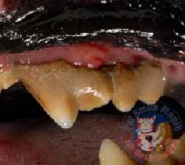It is important to start looking after your pet’s teeth from an early age, all throughout their life. Imagine how our teeth would look and our breath would smell if we didn't brush our teeth regularly.
It is just the same for your pet. Ideally you should begin brushing their teeth between 8 and 12 weeks of age as this enables them to become accustomed to it before their permanent dentition develops- but it is never too late to start!
The brushing motion removes the plaque which builds up on their teeth. It is soft and pasty and not easy to see. It builds up on teeth 24 hours a day and harbours bacteria which infect the gum tissue and roots of the teeth. It also causes bad breath. Unless the plaque is removed on a regular basis their gums can become sore and inflamed.
The plaque eventually calcifies and turns into tartar which is the hard brown material that becomes visible on your pet’s teeth. If left, it can lead to periodontal disease and loss of their teeth. The bacteria in plaque can even spread to other parts of the body and have been linked to heart, liver and kidney disease.
Once the tartar is formed it can only be removed by your veterinary surgeon giving your pet a general anaesthetic and removing it using an ultrasonic scaler. Sometimes at this stage some teeth will require removing and the remainder will be polished. Strict aftercare at home will need to be undertaken to prevent another dental procedure being needed.
 It is important to use a toothbrush and toothpaste designed for animals as the brush is ultra soft and shaped to fit their mouth and teeth. The toothpaste is flavoured to appeal to animals- fish flavoured for cats and poultry flavoured for dogs. It is also fine to be swallowed unlike human toothpaste which requires rinsing and contains fluoride. The paste contains an ingredient which helps prevent plaque from sticking to your pet’s teeth after brushing. A range of kits are available at the veterinary practice.
It is important to use a toothbrush and toothpaste designed for animals as the brush is ultra soft and shaped to fit their mouth and teeth. The toothpaste is flavoured to appeal to animals- fish flavoured for cats and poultry flavoured for dogs. It is also fine to be swallowed unlike human toothpaste which requires rinsing and contains fluoride. The paste contains an ingredient which helps prevent plaque from sticking to your pet’s teeth after brushing. A range of kits are available at the veterinary practice.
Your pet’s normal diet, especially if tinned, allows for food to stick to their teeth and favours the growth of bacteria found in plaque which is why home dental care is so important. There is a range of dental biscuits, rinses and chews available from the practice which can help along with brushing to keep their teeth clean by limiting dental plaque and tartar formation.
The Royal Canin Dental diet, available for cats and dogs is specially formulated and works by 2 actions:
Mechanical action: the kibble's special texture means that when eaten the tooth will bite right into it. The abrasive effect of contact breaks down dental plaque and disperses bacteria.
Biochemical action: micronised sodium polyphosphate is dispersed into the mouth and traps calcium present in saliva before it can build up on plaque which is present on the teeth. By making the calcium unavailable, tartar formation is delayed.
Small breed dogs are especially susceptible to dental problems, which is why Royal Canin also put sodium polyphosphate in their Vet Care range of diets as well for tartar control.
Chews are also very good at reducing plaque formation but generally they can only clean the prominent areas of your dog’s teeth.
To enable your pet to enjoy having their teeth cleaned be patient and take time with the process. Try following these steps and your pet will quickly get used to the process:
Day 1: Gently stroke the outside of your pet's cheeks with your finger only (no brush) and slowly lift their lip for about 30 seconds. Reward, praise and treat at the end of each session.
Day 2: Repeat as above and also place a small amount of toothpaste on the end of your finger and let your pet sample it.
Day 3: Repeat Day 2, but this time, gently run your finger or toothbrush and a small amount of toothpaste over your pet's teeth for 30-45 seconds. Never start at the front of the mouth as this is the most sensitive part. Reward with praise and a treat. It sometimes helps to smear the toothpaste into the brush so your pet does not lick it off straight away!
Day 4: Repeat Day 3 adding 15 seconds to the time running over your pet's teeth. Reward with praise and a treat.
Day 5: Gradually you should be aiming to spend about a minute on each side of their mouth, brushing horizontally for cheek teeth and vertically for their canine teeth.
Ideally try to brush your pet’s teeth once a day, usually bedtime is a good time followed by a dental biscuit or chew as a reward.
If you would like more advice on the best way to care for your pet’s teeth please speak to your veterinary nurse at your local branch of Cinque Ports Vets.
Videos - How to brush your pet's teeth:




